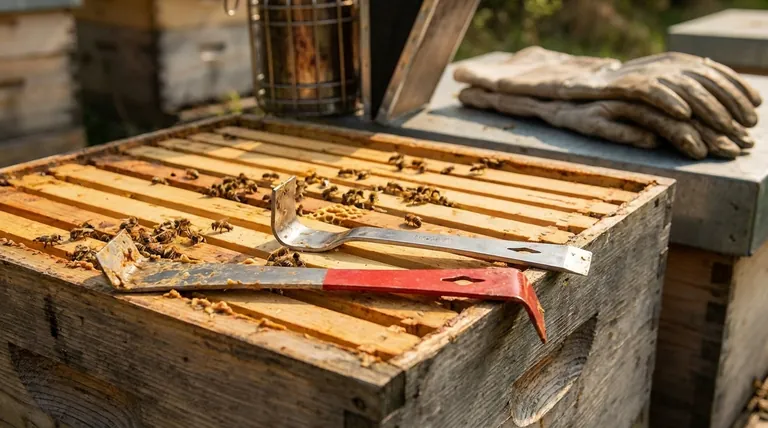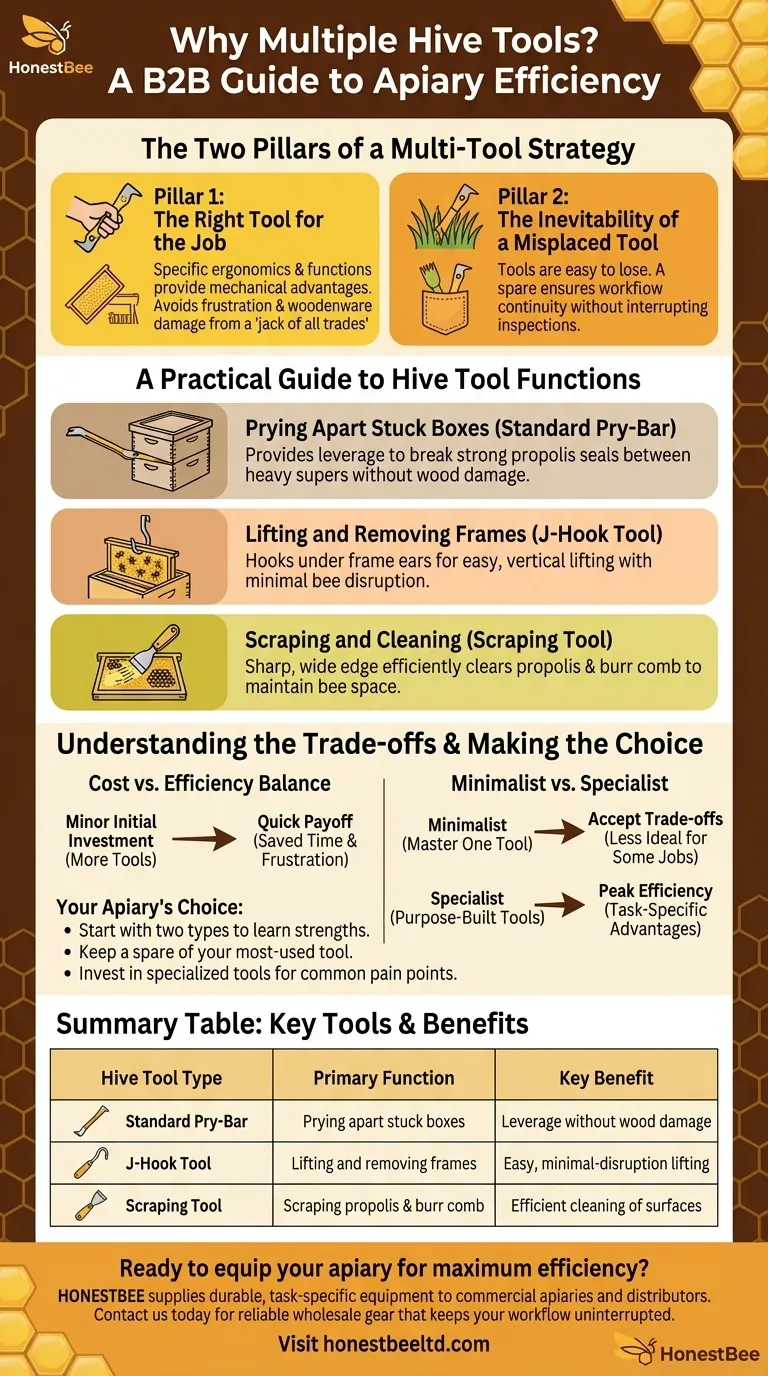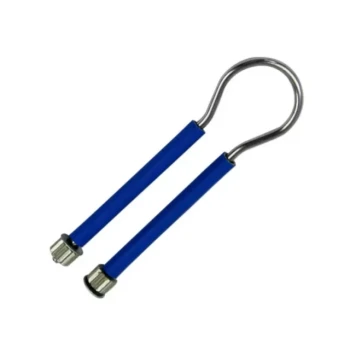At its core, the recommendation to have multiple hive tools is based on two fundamental principles of efficient beekeeping: having the right tool for the specific job at hand and ensuring you always have a backup for a tool that is frequently misplaced. This simple practice prevents workflow interruptions and makes tasks like prying boxes, lifting frames, and scraping propolis significantly easier.
Owning multiple hive tools is not about redundancy; it's about building a versatile and resilient toolkit. Different tool designs excel at different tasks, and having spares ensures that losing a tool mid-inspection doesn't derail your work.

The Two Pillars of a Multi-Tool Strategy
The logic behind carrying more than one hive tool is rooted in practical, real-world beekeeping scenarios. It addresses both the limitations of a single tool and the realities of working outdoors.
Pillar 1: The Right Tool for the Job
Not all hive tools are created equal. Different styles are designed with specific ergonomics and functions in mind, providing mechanical advantages for certain tasks.
A single tool might be a "jack of all trades," but it's often a master of none. Trying to use a single design for every job can lead to frustration, wasted effort, and even damage to your woodenware.
Pillar 2: The Inevitability of a Misplaced Tool
Hive tools are notoriously easy to lose. They are often coated in dark propolis and wax, making them difficult to spot if you set them down in the grass or on a neighboring hive cover.
Having a spare on hand, either in your pocket or your bee box, means you can continue your inspection without a frustrating trip back to the shed or garage to find another one.
A Practical Guide to Hive Tool Functions
While there are many variations, most hive tools are designed to excel at a few core functions mentioned in the references: prying, scraping, and lifting. Understanding these functions clarifies why having more than one type is so beneficial.
For Prying Apart Stuck Boxes
Hive boxes are often glued together tightly with propolis, a sticky resin bees produce. Separating them requires significant leverage.
A standard hive tool (often a simple pry bar design) is excellent for this. Its wider, flatter edge provides a large surface area to break the propolis seal between heavy supers without damaging the wood.
For Lifting and Removing Frames
Frames can also be sealed in place with propolis and wax. Getting the first frame out of a packed box is often the most difficult part of an inspection.
A J-hook hive tool is specifically designed for this task. The "J" end hooks under the frame's ear, allowing you to use leverage against the adjacent frame to lift it straight up, minimizing disruption to the bees.
For Scraping and Cleaning
Both propolis and burr comb must be regularly scraped from frames and hive bodies to maintain proper bee space and keep equipment clean.
Most tools feature a sharp, flat edge for scraping. However, some designs offer a wider or beveled blade that is more efficient for cleaning large surfaces, again demonstrating the value of having the right design for the task.
Understanding the Trade-offs
While the benefits are clear, it's important to approach your toolkit with a clear purpose.
The Cost vs. Efficiency Balance
More tools mean a slightly higher initial cost. However, this minor investment pays for itself quickly through saved time and reduced frustration during hive inspections.
The Minimalist vs. The Specialist
Some beekeepers prefer a minimalist approach, mastering a single favorite tool for nearly every task. This is a valid choice, but it requires accepting the trade-off of using a less-than-ideal tool for certain jobs. The specialist, by contrast, values the peak efficiency gained from using a purpose-built tool.
Making the Right Choice for Your Apiary
Ultimately, your toolkit should match your goals and working style.
- If your primary focus is getting started: Begin with two distinct types, such as a standard pry-bar tool and a J-hook tool, to learn their respective strengths.
- If you manage multiple hives: Always keep at least one spare of your most-used tool in your bee kit or vehicle to prevent a lost tool from halting your work.
- If your primary focus is maximizing efficiency: Observe your workflow and invest in specialized tools that solve your most common pain points, whether it's lifting frames or scraping boxes.
A well-considered toolkit is the foundation of a prepared and confident beekeeper.
Summary Table:
| Hive Tool Type | Primary Function | Key Benefit |
|---|---|---|
| Standard Pry-Bar | Prying apart stuck boxes | Provides leverage to break propolis seal without damaging wood |
| J-Hook Tool | Lifting and removing frames | Hooks under frame ears for easy, minimal-disruption lifting |
| Scraping Tool | Scraping propolis and burr comb | Sharp, wide blade for efficient cleaning of frames and hive bodies |
Ready to equip your apiary with the right tools for maximum efficiency? As HONESTBEE, we specialize in supplying durable, task-specific beekeeping equipment to commercial apiaries and distributors. Whether you need standard pry-bars, J-hook tools, or specialized scrapers, our wholesale-focused operations ensure you get reliable gear that keeps your workflow uninterrupted. Don't let a misplaced tool slow you down—contact us today to discuss your hive tool needs and see how we can support your beekeeping success!
Visual Guide

Related Products
- Professional Steel Pry-Bar Hive Tool with Painted Grip
- HONESTBEE Advanced Ergonomic Stainless Steel Hive Tool for Beekeeping
- HONESTBEE Professional Multi-Functional Hive Tool with Ergonomic Wood Handle
- HONESTBEE Professional Long Handled Hive Tool with Precision Cutting Blade
- Professional Compact Multi-Function Uncapping Knife for Beekeeping
People Also Ask
- What are some safety precautions and care tips for hive tools? Ensure Beekeeping Efficiency and Hive Health
- Why is it recommended to have multiple hive tools on hand? Essential Tips for Efficient Beekeeping
- What is a standard hive tool and what are its features? The Essential Multi-Function Tool for Beekeepers
- What equipment and implements are needed by beekeepers besides the hives? Build Your Essential Beekeeping Toolkit
- What are hive tools used for in beekeeping? Essential Gear for Efficient Hive Management



















